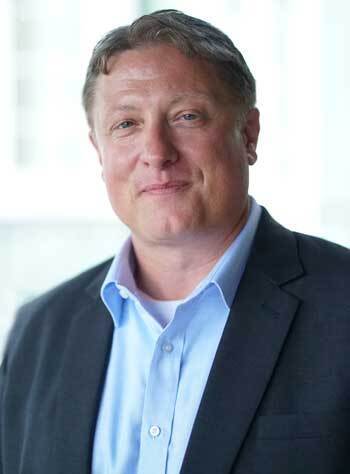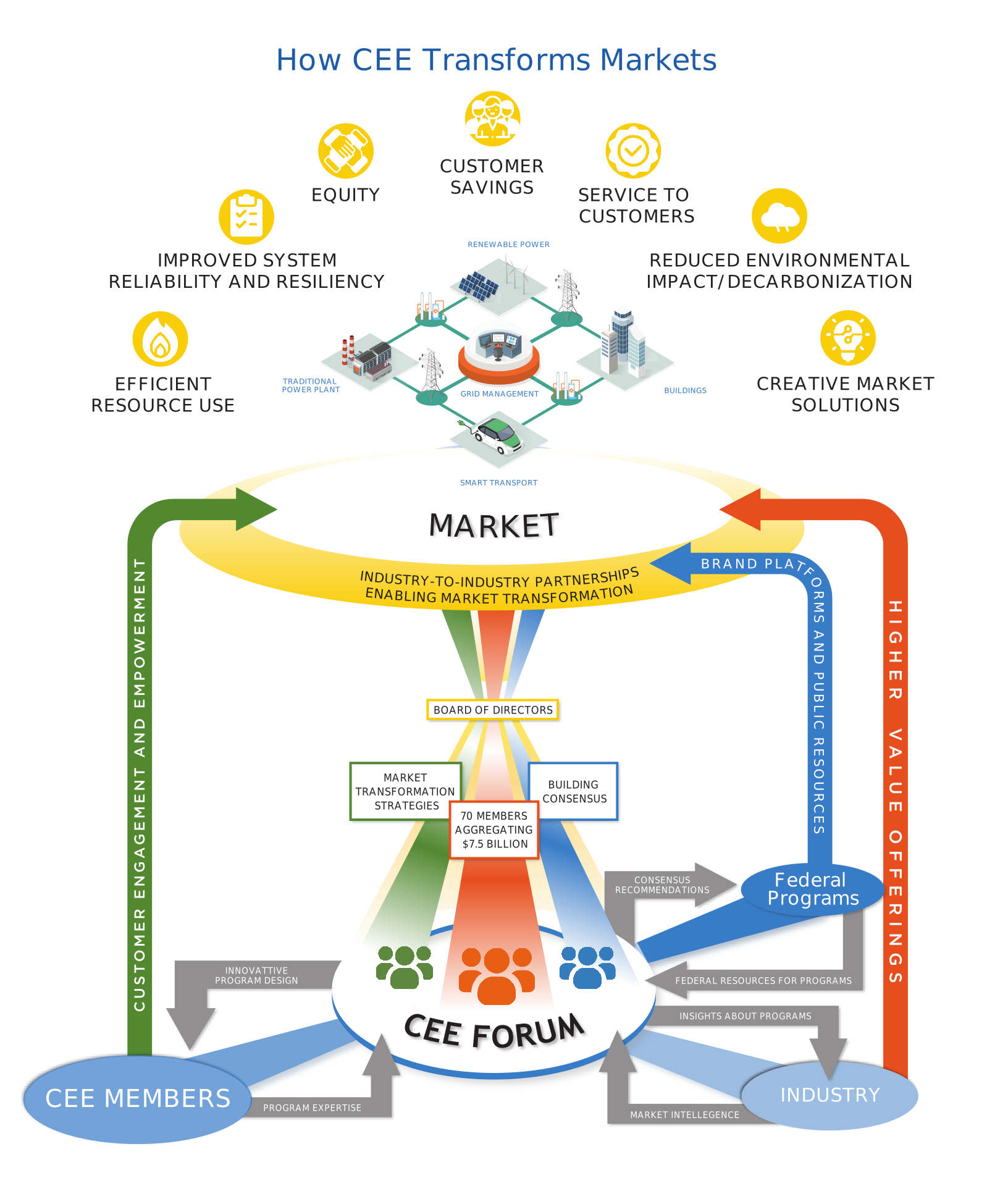Introduction





Leadership Message
A foundational principle of the Consortium is working together to achieve lasting structural market change. CEE is a consortium of investor-owned and municipal utilities, national labs, nonprofit DSM and market transformation program administrators, and supportive state and federal agencies. Members are responsible for approximately $7 billion of the $9 billion budgeted annually for demand side investment in the US and Canada and serve nearly 100 million electric customers and 50 million gas customers. CEE’s purpose is to serve administrators of demand side programs that actively support customers in their journey to manage energy wisely. CEE channels our members’ strategic objectives in order to gain strength in numbers and transform markets.
It is difficult to discuss 2022 and CEE without referencing the Inflation Reduction Act. Related to efficiency, the historic passing provided substantial funding for state energy office efficiency programs as well as tax credits utilizing CEE Tiers for the next decade. At CEE, members are collaborating with federal agencies, trade associations, and the entire heat pump supply chain to pursue the often unseen and underappreciated work of program design, trade ally support, and contractor education. As detailed in our report, transforming markets for efficient, connected heat pump technology is expanding from ducted and ductless systems to super efficiency room conditioner with a form factor suited to window installations.
Our annual report also details efforts by members to increase the ability for energy efficiency programs to serve a broader array of customers, many of whom are historically underserved.
CEE’s 18 Initiatives address a wide breadth of industries, ranging from commercial heat pump water heaters to residential HVAC systems that leverage variable speed heat pump technology to reduce energy use and provide demand flexibility. Members understand that the time and location of savings are critical for meeting today’s decarbonization and reliability objectives, and are working directly with manufacturers to deploy systems capable of shedding, shifting, and delaying energy use. CEE Initiatives seek to reward market players whose leadership creates products and services of ever greater value to utility customers and systems and accordingly improves the livelihood of society.
At the Consortium for Energy Efficiency, leading United States and Canadian efficiency program administrators develop consensus-based strategies to accelerate adoption of cutting-edge energy efficiency and load management solutions that benefit all customers, reduce carbon, and improve the reliability of energy delivery systems.
We invite you to review the highlighted work of 2022 and look forward to your engagement and support in the years to come.
Member Listing
Program Administrators- Ameren Illinois
- Avangrid
- Avista
- Baltimore Gas and Electric Company
- BC Hydro
- Berkshire Gas
- Cape Light Compact
- Commonwealth Edison Company
- Connecticut Natural Gas
- Consolidated Edison Company
- Consumers Energy
- DC Sustainable Energy Utility (DCSEU)
- DTE Energy
- Dominion Energy—Utah
- Duke Energy
- Efficiency Maine
- Efficiency Vermont
- Elizabethtown Gas
- Enbridge Gas
- Énergir
- Energy Trust of Oregon
- Eversource
- FortisBC
- Hawaiʻi Energy
- Hydro-Québec
- IESO
- Idaho Power
- Los Angeles Department of Water & Power
- National Grid
- Natural Resources Canada
- New Jersey Natural Gas
- New Mexico Gas Company
- New York Power Authority
- New York State Electric & Gas
- New York State Energy Research and Development Authority
- Nicor Gas
- Northern California Power Agency
- Oncor
- Orlando Utilities Commission
- PNM
- PSEG Long Island
- Pacific Gas and Electric Company
- Peoples Gas
- Public Service Electric & Gas
- Puget Sound Energy
- Rochester Gas & Electric
- Sacramento Municipal Utility District
- Seattle City Light
- Snohomish County PUD
- SoCalGas
- South Jersey Gas
- Southern California Edison
- Southern Connecticut Gas
- Southern Minnesota Municipal Power Agency
- Southwest Gas
- Tacoma Power
- Tampa Electric
- Tennessee Valley Authority
- United Illuminating
- Unitil
- Vectren Corporation—Ohio
- Vermont Department of Public Service
- Vermont Gas
- Wisconsin Focus on Energy
- Xcel Energy
Member Listing
Efficiency Organizations and National Labs- American Council for an Energy-Efficient Economy
- California Energy Commission
- California Institute for Energy and Environment
- Fraunhofer USA Center for Manufacturing Innovation CMI
- Lawrence Berkeley National Laboratory
- National Renewable Energy Laboratory
- Natural Resources Defense Council
- Northwest Energy Efficiency Alliance
- Oak Ridge National Laboratory
- Pacific Northwest National Laboratory
- Southwest Energy Efficiency Project
Member Listing
Government Agencies- Department of Energy
- Environmental Protection Agency
- Natural Resources Canada


Board
-
SARAH VAN DER PAELT
Chair, Enbridge Gas -
FRANK GUNDAL
First Vice Chair, Eversource -
DR. DAVID GOLDSTEIN
Second Vice Chair, Natural Resources Defense Council -
DANIEL ZAWESKI
Treasurer, PSEG Long Island -
CINDY HERRON
Secretary, Tennessee Valley Authority -
GILBERT ARCHULETA
Puget Sound Energy -
NAOMI BAUM
American Council for an Energy Efficient Economy -
JOHN BOLADIAN
DTE Energy -
MICHAEL BURGER
Pacific Gas and Electric -
HAMMAD CHAUDHRY
Avangrid -
DARREN HANWAY
SoCalGas -
STEVE HOBSON
BC Hydro -
RACHEL HUANG
Sacramento Municipal Utility District -
GARRY JONES
Oncor -
DENISE MUNOZ
ComEd -
CHRIS PORTER
National Grid -
JOHN RAUDENBUSH
New York Power Authority -
MARK SCHOENHEIDER
Xcel Energy -
TRACY SCOTT
Energy Trust of Oregon -
BECKY WALKER
Northwest Energy Efficiency Alliance -
JOY ZINS
Duke EnergySpecial Advisors
Special Advisors
-
TRACEY KUTNEY
Natural Resources Canada -
HENRY MCKOY
US Department of Energy -
MAUREEN MCNAMARA
US Environmental Protection Agency
Staff
-
Kira Ashby
Principal Program Manager -
Ben Chadwick
Program Assistant -
Michael Colaneri
Strategic Communications Manager -
Adam Cornelius
Senior Program Manager -
Hale Forster
Principal Program Manager -
Ryan Hamilton
Principal Program Manager -
Emma Hanson
Senior Program Manager -
Bjorn Jensen
Senior Program Manager -
Evelyn Lane
Program Assistant -
Walker Larsen
Principal Program Manager -
Kristin Luft
Data Management and Analysis Associate -
Erik March
Program Assistant -
Jack Monte
Director of Finance and Administration -
Thomas Olson
Program Associate -
Alice Rosenburg
Deputy Director -
Maya Saterson
Program Associate -
Laney Sullivan
Program Associate -
Christopher Sullivan-Trainor
Senior Program Manager -
John Taylor
Executive Director
2022 Highlights
The Center for Equity and Energy Behavior
Building New Metrics for Success
INFLATION REDUCTION ACT (IRA) DEPLOYMENT
Serving Customers by Supporting Trade Allies and Coordinating Ratepayer and Taxpayer Funded Efficiency.
SERC
Super-Efficient Window Heat Pump as Multifamily Market Mover
SECTOR REPORTS
SECTOR REPORTS
Residential
Expansion of the CEE Integrated Home
The sector-encompassing CEE℠ Integrated Home Initiative, launched in 2021], establishes a suite of binational product specifications across categories that define the embedded capabilities and connectivity features of residential products that members have deemed necessary to achieve a grid-interactive, interoperable, and demand flexible home. As members’ program portfolios and objectives evolve in response to the increased penetration of distributed energy resources, regulatory and policy drivers related to decarbonization, and rapid technology changes, program administrators envision Version 2.0 of the Initiative to address expanded opportunities for energy efficiency, load management, and greenhouse gas reduction.
CEE began deliberation around considered expansion of the Integrated Home Initiative to address strategic load management opportunities, such as electric vehicles and supply equipment, home energy management systems (HEMS), and battery storage. For 2023, CEE will be actively considering refinements to the Integrated Home Minimum Requirements and product-specific connected specifications to help program administrators achieve future load flexibility goals.
The third annual cycle of the Integrated Home Competition was launched, which seeks efficient, interoperable, and demand flexible products across a wide range of categories in support of the CEE Integrated Home vision. CEE introduced HEMS as a formal Competition entry category in 2023; this category is intended to be broad and capture a variety of product types, including smart breaker and electric panel equipment, as well as other devices with whole home energy management capabilities. CEE staff attended various industry events throughout the year to endorse 2022 winners and recruit entrants for the 2023 Competition cycle.
Revised CEE Residential HVAC and Water Heating Initiatives Published
The CEE℠ Residential Heating and Cooling Systems Initiative was revised along with the associated Electric Equipment Specifications for central air conditioners (CACs) and air-source heat pumps (ASHPs) in response to new federal minimum standards and associated test procedures. The revised specifications reflect changes to the M1 Appendix metrics (SEER2, EER2, and HSPF2), which are designed to represent improvements that more accurately reflect field conditions compared to the previous M Appendix. The updated Initiative also includes a COP at 5°F ≥ 1.75 requirement for all products in the North and Canada region, with the provision that, for the duration of the 2023 calendar year, COP at 5°F ≥ 1.75 may be met using the Appendix M1 test method or via a DOE sanctioned calculation methodology based on COP at 17°F and COP at 47°F.
In January 2023, the revised CEE℠ Residential Water Heating Initiative and associated specification criteria went into effect. The scope of approved changes includes increased performance requirements for electric heat pump water heaters (HPWHs) (including a connectivity and automated load management requirement for the Advanced Tier), new categories for split-system HPWHs and 120V electric HPWHs, a new Advanced Tier for gasfired storage water heaters, increased performance requirements for gas-fired tankless water heaters, and expansion of the optional connected specification scope to gas-fired water heaters. Members are in ongoing discussion regarding how CEE can support efforts to encourage program participation and drive uptake of high-efficiency water heater sales through binational coordination.
CEE Qualified Product Directory Update
With the passage of the Inflation Reduction Act of 2022 (IRA), CEE tiers were given tremendous standing by being named in the 25C Section as the basis for federal tax credits across several product categories through 2032. During the first several months of 2023, CEE staff worked closely with both the Air-Conditioning, Heating, and Refrigeration Institute (AHRI) and US Department of Energy (DOE) to establish a temporary list of regularly updated spreadsheets that represent residential products meeting CEE’s highest non-Advanced Tier, which was launched earlier this year.
The CEE Directory, which has served for over a decade as a public-facing resource for contractors, consumers, and program administrators to identify efficiency performance information for residential and commercial central air conditioners (CACs), air source heat pumps (ASHPs), furnaces, boilers, and water heaters, is now live and available for public access. The Directory includes lists compiled by the US DOE that identify product models that meet the criteria for CEE’s highest non-Advanced Tier as specified within Section 25C of the 2022 IRA. CEE has been working in collaboration with the US DOE, AHRI, and individual manufacturers to create a validated means to represent those models that are likely (pending IRS guidance) to meet the IRA criteria for 25C tax credit. The list is being actively monitored and updated every two weeks by DOE. The page will be updated accordingly as additional information is provided by the US Treasury regarding 25C tax credits. AHRI is continuing to support CEE’s full searchable Directory to reflect the transition to the M1 Appendix and the revised Initiatives for HVAC and water heating.
ASHP QI Sponsored Project to Ensure Efficient In-Field Equipment Performance
In early 2023, CEE published deliverables of the CEE ASHP Education and Awareness Building Strategies Sponsored Project, intended for members to deploy locally to address challenges with proper design, sizing, installation, and maintenance of ASHPs. These resources are based on primary and secondary research as well as input from the Advisory Committee; Phase I outputs include:
- CEE Resources Inventory
- CEE Resource Review
- CEE Voice of the Experts Book
- Draft Decision Tree
- CEE Needs Assessments Report
Phase II of the ASHP Sponsored Project, which entails the creation of guides, trainings, and peer-to-peer learning focused on program administrators and other organizations well positioned to influence contractors and technicians, began earlier this year. Forthcoming deliverables include:
- Duct Retrofit Decision Guide
- System Design with Existing Heating Guide
- Weatherization Guide
- “You Installed a Heat Pump, What Now?” Guide
- Heat Pump Design Decision Matrix and System Design Guide
- Integrated Controls Guide
For additional information, contact Emma Hanson.
SECTOR REPORTS
Commercial and Industrial
The Next Phase of Strategic Energy Management
The CEE SEM Initiative launched in 2014 to help support the broader adoption of programs by defining what SEM is from an energy efficiency program perspective and providing program examples that follow a shared set of elements, demonstrating consistent outcomes based on supporting those program elements. In 2021 the Committee collected information about the different approaches SEM programs take to support customers addressing the CEE Minimum Elements as means to practicing SEM. Based on the information shared and discussions by the Committee and with Industry Partners, in 2022, the Committee delved into the details where a variety of support approaches seemed to indicate an opportunity to clarify intent. The Committee discussed Energy Management Assessments, Energy Maps, Metrics and Goals, and Measurement, Data Collection, and Analysis. Following the call series, the Committee documented the discussions and outcomes along with recommendations for possible additional actions. These opportunities and possible program actions were further discussed with SEM implementers and other market actors at the 2022 CEE Industry Partners Meeting. Through the call series and resulting industry engagement, the Committee was able to successfully ensure consistent understanding of the CEE SEM Minimum Elements by those who reference them. Further, the discussions set up the Committee for a full Initiative review 2023 to confirm the consortium’s SEM goals align with current program needs, and the promoted strategies support those objectives. Specifically, the Committee anticipates enhancing the CEE SEM strategy to identify and demonstrate successful outcomes of SEM as a framework for achieving decarbonization in addition to energy savings.
Expanding Commercial Water Heating Market Transformation Strategies: Heat Pump Solutions Emerge
CEE established a bi-national Natural Gas Commercial Water Initiative in 2012 to increase demand for more efficient products. The market has developed significantly since then, including the development of high-performance electric and gas heat pump water heaters. While still nascent in the market, these products are an exciting opportunity to help meet members’ decarbonization goals and provide customers with centralized commercial water heating solutions. The CEE Commercial Water Heating Committee is finalizing updates to the program and equipment performance specifications to present to the Board of Directors in 2023 which will include equipment specifications for gas and electric water heaters with corresponding strategies for addressing proper sizing and system design. CEE staff are also participating in the ANSI-AHRI 1530 Standards Working Group that is developing a test standard for load shifting commercial water heaters that will likely provide a basis for CEE members to promote demand flexible water heating systems. CEE is also working closely with US DOE and EPA ENERGY STAR to establish system level efficiency test methods that will ensure efficient in-field performance.
Continued Opportunities in Commercial Air Conditioning and Heat Pumps
The CEE℠ High Efficiency Commercial Air Conditioning and Heat Pumps (HECAC) Initiative aims to increase the availability of high efficiency commercial unitary and variable refrigerant flow (VRF) AC and HP equipment across the US and Canadian markets. In response to the increasing baselines and other market developments the Committee worked on revising the Initiative to support program administrators’ need to maximize energy savings, streamline selection of highly efficient commercial AC and HP equipment, and support continued investment in efficiency improvements by manufacturers. In 2022, the Committee developed a draft multitier specification intended to continue identifying unitary equipment that saves energy compared to changing energy efficiency program baselines, account for climate variability and member programs different objectives and drivers, better reflect the market opportunity to differentiate top performing VRF systems and recognize manufacturers for meeting higher levels of performance. The Committee also tackled the importance of load flexibility by supporting the creation of an ANSI standard for DR-enabled rooftop units, and assessing the applicability of the Residential CEE Energy Management Capabilities and Demand Response Criteria for Variable Capacity HVAC Systems as Connected Criteria for commercial equipment less than 65,000 Btu/h. The Committee supported gas heating efficiency by leveraging a new “whole box” efficiency metric in the recently published third edition of the Canadian Standard Association (CSA) P.8 Standard.
Updated Program Guide Keeps Commercial Kitchens Initiative Cooking
CEE published an updated Commercial Ice Machines Program Guide to support adoption of the revised CEE Commercial Ice Machines Specification. The updated Guide includes program design considerations, data on product availability, estimated energy saving, and market considerations specific to market segments that are significant purchasers of commercial ice machines including food service and sales, healthcare, hospitality, and education.
For more information, Contact Ryan Hamilton.
SECTOR REPORTS
Natural Gas
Advancing Available and Market-Ready Solutions to Save Energy and Reduce Emissions
CEE continues to develop and maintain specifications that define highly efficient equipment for residential forced hot air, residential boilers (hydronic) space heating, and gas-fired water heaters. CEE also engages leading manufacturers, trade allies, and implementers to discuss coordinated approaches to support the adoption of gas-powered heat pumps for space heating/cooling and heat pump water heaters for commercial applications, particularly for space heating applications. There is an opportunity to standardize system designs or packaging for individual applications to reduce installation time, cost, and efficacy. The CEE Commercial Boiler Systems Committee anticipates an approach for incorporating gas heat pumps into revisions for the CEE℠ Commercial Boiler System Initiative, likely as part of a system or tandem approach with a boiler.
CEE works across residential and commercial space and water initiatives to incorporate tiers that endorse gas heat pump technologies. A table summarizing the status of these designations is below.
| CEE Initiative | Product Category | Specification | Status |
|---|---|---|---|
| Residential Space Heating and Cooling Systems | Forced Hot Air <225,000 BTU/h | Advanced Tier: ≥ 120% AFUE; reporting metrics | Published January 2021 |
| Boilers (Hydronic) <300,000 BTU/h | Advanced Tier: ≥ 120% AFUE; Thermal Load Management; reporting metrics | ||
| Residential Water Heating | Res and Res-Duty Commercial Storage Water Heaters | Advanced Tier: ≥ 1.00 UEF | Published January 2023 |
| Commercial Water Heating | Commercial Storage Water Heaters | Advanced Tier: COP ≥ 1.0 | DRAFT |
| Commercial Boilers | Likely a tandem design with a boiler | Tier TBD: Condensing boiler with gas heat pump | In development |
As a part of supporting these solutions, CEE engaged with the American Gas Association (AGA) to ensure a clear understanding of CEE Initiatives, specifications, and tiers as they work to support the gas industry application of the Inflation Reduction Act and Bi-partisan Infrastructure Legislation. CEE Committees are also considering how these significant federal rebates and tax credits impact market strategies and shared objectives while maintaining CEE’s role of defining, promoting, and maintaining realistic, technology-agnostic market transformation Initiatives on behalf of members.
For more information, contact Walker Larsen.
SECTOR REPORTS
Evaluation & Research
Sharing Data on Non-energy Impacts
Program administrators are increasingly mindful of the need for equitable delivery of program offerings. Many underserved customer groups use little energy and face greater barriers to energy upgrades, making it difficult for members to achieve significant energy savings or cost effectiveness from these programs. Conversely, some segments of “underserved” have relatively high energy burden and could be beneficiaries of energy efficiency programs should the ability to identify those users exist, and we have a compelling, comprehensive narrative that will compel participation. Non-energy impacts (NEIs) have experienced a renaissance in recent years as program administrators seek to measure progress towards new goals and a better understanding of the true value of their programs in the market. To the extent cost-effectiveness tests include NEIs, accurately quantifying the nonenergy benefits of programs will also enhance portfolio performance. (for more information, see article about the Center for Equity and Energy Behavior).
Tackling Changing Program Administrator Goals
Energy efficiency has historically been deemed the least-cost resource, with energy savings often measured independent of time, essentially treating aggregate impacts as baseload. At times, either as a complement or alternative to energy savings, some states and provinces also sought to understand, and even target peak demand reduction as measured in kW savings within their portfolios. As investment of ratepayer funds sored, the goal of these programs was to deliver the most energy or demand savings in the most cost-effective manner using a variety of cost-effectiveness tests. However, with a broader multitude of values that members are managing to, and the range of cost effectiveness tests applied, the CEE Evaluation Committee works to support these goals by identifying credible impact assessment strategies. The Committee continued the investigation into both what metrics to measure and how to measure them in order to capture grid benefits associated with distributed energy resources, storage, and related technologies as well as time and locational value of energy saved.
Continued Research that Demonstrates Impact Over Time
CEE staff analyzed data reflecting more than 300 program administrators to successfully compile the CEE 2021 Annual Industry Report, creating a consistent and accurate picture of program expenditures, budgets, and savings across 50 states, the District of Columbia, and nine Canadian provinces. This is the sixteenth consecutive CEE annual report offering members and industry a credible resource demonstrating the annual size and impact of the DSM industry, as well as historical growths and trends. CEE staff collaborated with the American Gas Association and Efficiency Canada on this report.
CEE published several program summaries, revealing program landscape insights using data gathered from current CEE member programs across the United States and Canada. The resources provide a tool for tracking Initiative participation, reflecting market impact, and helping inform future direction of Committee work.
CEE staff also sponsored the 19th annual ENERGY STAR Household Awareness Survey with the US Environmental Protection Agency. CEE surveys households annually to track the value accruing to the ENERGY STAR® label and demonstrate the success of local promotion of the ENERGY STAR brand. Resulting insight and trendlines are critical to maintaining federal government and state regulatory support for the label, and in turn continuing to make the label available as a tool benefiting efficiency programs.
For more information, contact Hale Forster.
SECTOR REPORTS
Emerging Technologies
Comprehensive Catalog of Emerging Opportunities for Program Consideration
The Catalog of Emerging Opportunity Assessments provides a detailed overview of active CEE member pilot and project assessments on emerging technologies and innovative programs. The 2022 Catalog highlights eighty-eight new assessments conducted by 16 CEE member organizations bringing the cumulative database to include 1,621 member assessments.
The CEE Emerging Technologies Collaborative (ETC) selection and narrowing process occurs each year and consists of three discrete phases: nominating emerging opportunities considered to be timely and relevant, narrowing these to eight to 12 for preliminary research and discussion, and further narrowing two to four for additional exploration.
The ETC nominates emerging opportunities each year using a vetted scoring process to assess the impacts and feasibility of each opportunity, as well as each member’s level of interest. The nine selected in 2021 include:
- Automated Demand Response
- Bidirectional Electric Vehicle Charging
- Incorporating Building Codes and Standards Into Programs
- Commercial Dual Fuel Rooftop Units (RTUs)
- Community Ground Source/Geothermal Heat Pumps
- Emerging Aspects of Cold Climate Heat Pumps
- Heat Pumps That Reuse Hot Water Distribution Systems
- Opportunities to Combine Heat Pumps and Energy Recovery Ventilation (ERV)/Heat Recovery Ventilation (HRV)
- Split Incentives for Multioccupancy Buildings
The ETC Advisory Committee ranked the nine mentioned above, with the ultimate goal of determining which opportunities the group has the most interest in conducting extended research over the course of 2022 (and possibly beyond). The following three opportunities were chosen:
- Grid-Interactive Nonresidential Building Controls
- Nonresidential Central Heat Pump Water Heating Applications
- Artificial Intelligence and Machine Learning for Nonresidential Whole Building Energy Management
Committee Roundtables Provide Additional Research Dimension
Spotlight roundtables provide a dedicated forum for ETC Committee members to present on pilots or other research efforts currently being conducted within their organizations that might be of interest to other members. This work may be relevant to the EOs selected for preliminary or extended ETC research for that year, or it may serve to provide an additional dimension for committee members to consider—either in their own internal research or for future collective exploration by the Collaborative. ETC Committee members provided information about their own completed, active, and developing assessments via two spotlight roundtable discussions on the following topics:
- Energy Storage Solutions
- Electric Homes for New Construction
- Windows Research
- Stretch Energy Codes and Building Performance Standards
- All-electric Kitchens
- Technology and Automation in Demand Response Pilots
- Dynamic Rate Pilot
- Advanced Energy Communities Project Overview
For more information, contact Adam Cornelius.
Financials
2021 Financials (Audited)
Statement of Financial Position
Assets
| Cash and investments | $2,796 |
| Government grants and memberships receivable | $826 |
| Fixed assets, net of depreciation | $168 |
| Other assets | $111 |
| Total assets | $3,901 |
Liabilities and net assets
| Current liabilities | $707 |
| Long-term liabilities | $8 |
| Unrestricted net assets | $2,302 |
| Temporarily restricted net assets | $884 |
| Total liabilities and net assets | $3,901 |
Statement of Activities
Revenue and support from operations
| Membership dues and government grants | $2,680 |
| Net assets released from restrictions | $814 |
| Other income | $182 |
| Total revenue and support from operations | $3,676 |
Operating expense
| Program | $2,032 |
| Administration | $1,002 |
| Total operating expenses | $3,034 |
Nonoperating activities
| Increase (decrease) in net assets from operations | $642 |
| Unrealized gain on investments | $14 |
| Total increase (decrease) in net assets | $656 |
| Net assets, beginning of year | $2,530 |
| Net assets, end of year | $3,186 |
The Consortium for Energy Efficiency is a group of North American utility energy efficiency program administrators. For more than 30 years, Consortium members have developed cutting-edge strategies to accelerate the commercialization of energy efficient solutions to benefit gas and electric customers, utility systems, and the environment. In this work, CEE has successfully engaged with leading manufacturers, trade associations and other market stakeholders to develop win/win solutions that benefit all. Consortium work is guided by Initiatives that members voluntarily implement.
© 2013–2023 Consortium for Energy Efficiency, Inc. All rights reserved. Terms and conditions for use of this website.







